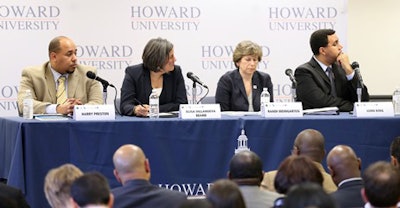 Photo courtesy of Oral Grant / FullTone Photography
Photo courtesy of Oral Grant / FullTone PhotographyWashington — The longstanding demographic mismatch between America’s public school teachers and the students they serve got a fresh airing Tuesday at Howard University, where a panel explored the nature of the problem and discussed a variety of potential solutions.
Acting U.S. Secretary of Education John B. King Jr. said the lack of diversity among America’s teachers emanates from problems of recruitment and retention.
“Without question, when you have a majority of students in our public schools who are students of color, but only 18 percent of teachers are of color and only 2 percent are African-American men, we have an urgent need to act,” King said during a panel discussion in the auditorium at Howard’s school of social work. “The question for the country is: How do we address this quickly and thoughtfully?”
In many ways, it was distressing to see the acting secretary lament the statistics that delineate the underrepresentation of minority teachers at the tail end of the second term of the Obama administration in much the same way that his predecessor, former Secretary of Education Arne Duncan, did about six years ago on the same campus.
Despite the longstanding recognition of the fact that America’s public school teachers are not demographically reflective of the students they serve, a report on hand at Tuesday’s event found “disquieting trends” in nine cities that “depart from the national trends” of gains in minority teacher representation—from 12 to 17 percent—of increases in the share of the teacher workforce among Asian and Pacific Islander, Black, Hispanic, American Indian and multiracial individuals.
“Specifically, we are very troubled by the fact that, in every city and every sector, the share of Black teachers in the workforce has been declining at rates ranging from the slight to the massive—from roughly 1 percent in Boston’s charter sector and Cleveland’s district sector to more than 24 percent in New Orleans (combined sectors) and nearly 28 percent in Washington, D.C. (combined sectors),” states the report, titled “The State of Teacher Diversity in American Education” and put out by the Albert Shanker Institute, a nonprofit endowed by the American Federation of Teachers.
Randi Weingarten, president of the American Federation of Teachers, suggested to King that the U.S. Education Department begin to track such statistics instead of having organizations such as the Shaker Institute have to compile the data—a suggestion that prompted King to jot down an apparent reminder to at least look into the matter.
Elisa Villanueva Beard, CEO of Teach for America, an organization that provides an alternative path to teaching through an intense summer training institute, touted her organization’s effectiveness in infusing more diversity into America’s schools.
Specifically, she said 49 percent of TFA’s incoming corps are teachers of color, with 21 percent being African-American compared to 7 percent nationally, and 14 percent being Latino compared to 8 percent nationally.
“The core issue here is when we talk about educational equality at the core of its race and class and privilege,” Beard said. “We have to take it head on.”
Beard stressed the importance of “cultural competence” among teachers but conceded that being a teacher of color is not synonymous with being culturally competent.
She downplayed criticism that TFA teachers being uncertified does a disservice to children of color, who disproportionately are taught by uncertified teachers, according to research cited at the forum, and lamented that America’s public schools are besieged by low expectations.
“We do not expect to be teaching the next CEO of an organization or institution,” Beard said of America’s teachers in general. “Because it’s a systemic problem it requires that we have all hands on deck and it requires leadership.”
Harry F. Preston V, a teacher and Baltimore Teachers Union Teacher Leader and TFA alumnus, complained of how being one of the few minority teachers on staff often leads minority teachers to be perceived as the “go-to” person for diversity issues, even though, he said, not all minorities share the same view.
“We carry the entire race on our shoulder every time we walk through the door,” Preston said.
He also spoke of challenges in retention. “Teachers like myself have a very difficult time staying in the classroom,” Preston said, citing the “working conditions.”
The statement echoed the Shanker report, which found that “the primary obstacle to faster diversification of the American teaching force was not insufficient recruitment and hiring of more minority teachers but their comparatively high attrition rates.”
King, the acting education secretary, spoke of a “tax” that minority male teachers must pay when their colleagues try to saddle them with responsibility for dealing with the most challenging male students as opposed to relying on them for more academic engagement.
Preston, who is CTE co-department chair and an Engineering Pathway instructor at Edmondson Westside High School in Baltimore, said his ethnic background, being African-American and “mixed with a lot of stuff,” helps expose students to more diverse viewpoints. He spoke of his background in physics, engineering and business.
“Who else to better teach our students those things,” said Preston, who is a candidate for the Baltimore City Council. “You kind of want people with diverse backgrounds because you want people with different life experiences that say, ‘Yes, the book says this but let’s look at it this way.’”
Jamaal Abdul-Alim can be reached at [email protected] or follow him on Twitter @dcwriter360.


















